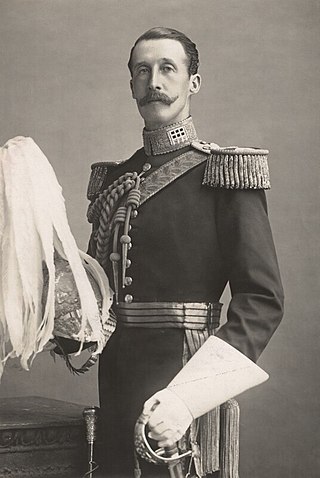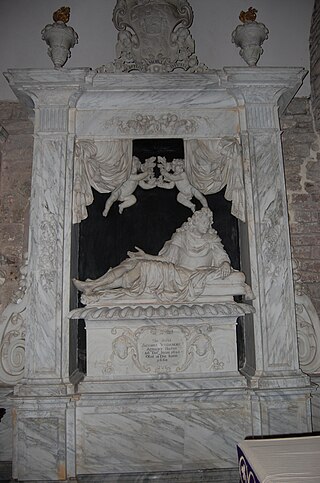
Hereford is a cathedral city and the county town of Herefordshire, England. It lies on the River Wye, approximately 16 miles (26 km) east of the border with Wales, 23 miles (37 km) north-west of Gloucester and 24 miles (39 km) south-west of Worcester. With a population of 53,112 in 2021, it is the largest settlement in Herefordshire.
The history of Herefordshire starts with a shire in the time of King Athelstan, and Herefordshire is mentioned in the Anglo-Saxon Chronicle in 1051. The first Anglo-Saxon settlers, the 7th-century Magonsætan, were a sub-tribal unit of the Hwicce who occupied the Severn valley. The Magonsætan were said to be in the intervening lands between the Rivers Wye and Severn. The undulating hills of marl clay were surrounded by the Welsh mountains to the west; by the Malvern Hills to the east; by the Clent Hills of the Shropshire borders to the north, and by the indeterminate extent of the Forest of Dean to the south. The shire name first recorded in the Anglo-Saxon Chronicle may derive from "Here-ford", Old English for "army crossing", the location for the city of Hereford.

Fownhope is a village in Herefordshire, England, an area of outstanding natural beauty on the banks of the River Wye. The population of the village at the 2011 census was 999.

Charles FitzRoy-Scudamore was a British politician who sat in the House of Commons for 49 years from 1733 to 1782.

Viscount Scudamore was a title in the Peerage of Ireland held by three generations of the Scudamore family. It was created on 1 July 1628 for the diplomat and politician Sir John Scudamore, 1st Baronet. He had already been created a Baronet, of Holme Lacy in the County of Hereford, in the Baronetage of England on 1 June 1620, and was made Baron Dromore at the same time as he was granted the viscountcy, also in the Peerage of Ireland. Scudamore was the son of Sir James Scudamore and the grandson of Sir John Scudamore. Lord Scudamore was succeeded by his grandson, the second Viscount. He represented Hereford and Herefordshire in Parliament. On his death the titles passed to his son, the third Viscount. He was also Member of Parliament for Hereford and Herefordshire. The titles became extinct on his death in 1716.

Edwyn Francis Scudamore-Stanhope, 10th Earl of Chesterfield,, styled Lord Stanhope between 1883 and 1887, was a British peer and courtier.
George Payne was an English official of the Exchequer and Freemason.
Sir John Scudamore was a 15th-century English landowner from Herefordshire who acted as constable and steward of a number of Royal castles in South Wales. Active in fighting with the Welsh in 1402, he was still living in 1432, when it was discovered that he had married a daughter of Owain Glyndŵr.
Henry Edwyn Chandos Scudamore-Stanhope, 9th Earl of Chesterfield, DL, JP was a British peer.

John Scudamore, 1st Viscount Scudamore was an English diplomat and politician who sat in the House of Commons at various times between 1621 and 1629. In 1628 he was created Viscount Scudamore in the Irish peerage.

Sir James Scudamore was a gentleman usher at the court of Queen Elizabeth I. Born at Holme Lacy, Herefordshire, he was the eldest son of John Scudamore, Custos Rotulorum of Herefordshire and his first wife Eleanor Croft, daughter of former Lord Deputy of Ireland James Croft. He would assume that title in 1616, and remained Custos Rotulorum for two years until his own death in 1619. Scudamore was respected for his tilting skill and his embodiment of the ideals of chivalry.

James Scudamore was an English politician who sat in the House of Commons at various times between 1642 and 1668.

James Scudamore, 3rd Viscount Scudamore, was an English landowner and Tory politician who sat in the House of Commons from 1705 to 1716.

St Cuthbert's Church is a redundant Anglican church about 1 mile (1.6 km) to the southeast of the village of Holme Lacy, Herefordshire, England. It stands in an isolated position at the end of a lane in a bend of the River Wye. It is designated in the National Heritage List for England as a Grade I listed building, and is under the care of the Churches Conservation Trust.

The Redstreak, also spelt Redstrake, Red Streak or Red-streak, is or was a very old variety of cider apple formerly commonly planted in England.
Warner Leisure Hotels is a hospitality company owning 14 country and coastal properties around the UK in North Wales, Somerset, Herefordshire, Berkshire, North Yorkshire, Nottinghamshire, Isle of Wight, Suffolk, Hampshire and Warwickshire. Founded in 1932 as Warner Holiday Camps, later known as Warner Holidays and has been adult only since 1994. In the 1990s Warner's started developing country house hotels and changing their existing 'camps' into coastal resorts and hotels.
Frances Scudamore, Duchess of Beaufort (1711–1750) was a noblewoman and heiress. The only child of James Scudamore, 3rd Viscount Scudamore, she was his sole heir upon his death in 1716. Her mother, Frances née Digby, had introduced the family to Alexander Pope. Frances married, on 28 June 1729, Henry Somerset, 3rd Duke of Beaufort, who the following year took the surname Scudamore by Act of Parliament. The marriage was not a happy one, leading the Duchess to have an affair with William Talbot, 2nd Baron Talbot. In 1742, the Duke filed for divorce due to this affair; the Duchess countersued, claiming that the Duke was impotent. When the Duke disproved her claim before court-appointed examiners, the divorce was granted in March 1743, followed by the Duke suing Lord Talbot for damages.

Frances Scudamore (1750–1820) was the second wife of Charles Howard, who became the 11th Duke of Norfolk in 1786. She spent her married life confined to Holme Lacy in a mentally deranged condition.
The Scudamorefamily is an English noble family. The family settled in Herefordshire at two seats, Holme Lacy and Kentchurch Court, before lines moved to Devon, Somerset and Derbyshire. The family first gained prominence in the 15th and 16th centuries, before becoming ennobled as Viscount Scudamore and Baron Dromore in the 17th century, and were granted two baronetcies in 1620 and 1644. The family married into several noble dynasties including the Cecil, Beaufort, and Howard families, and became ancestors to the Earls of Chesterfield.
Sir Barnabas Scudamore (1609–1651) was an English military commander and active Royalist during the English Civil War. The son of James Scudamore and younger brother of Viscount Scudamore, he was from a prominent Herefordshire landowning family. His family's seat was at Holme Lacy.










